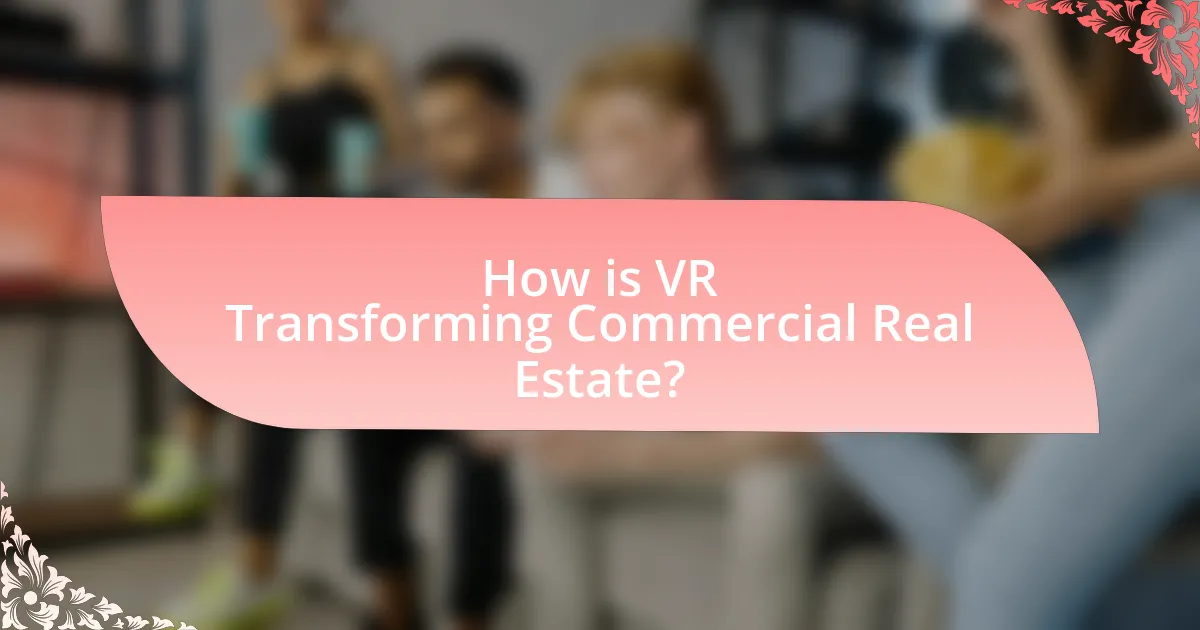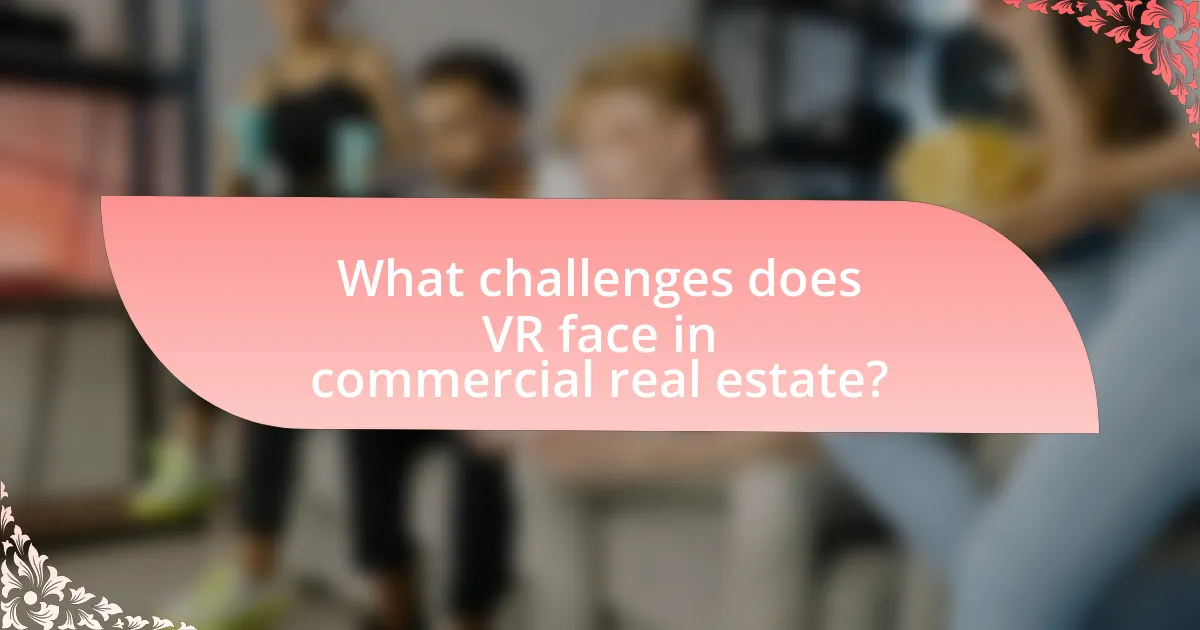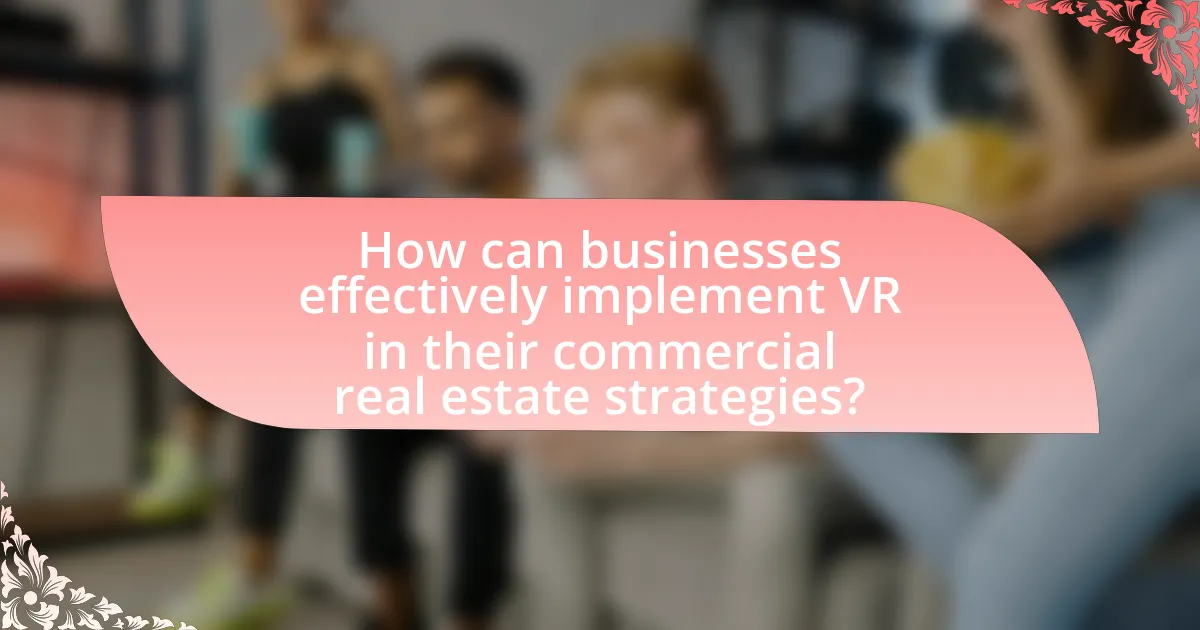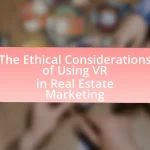Virtual Reality (VR) is significantly transforming the commercial real estate sector by enhancing property visualization and improving client engagement through immersive virtual tours. Key applications of VR include virtual property tours, design visualization, and innovative marketing strategies, which collectively increase buyer interest and streamline the leasing process. Despite challenges such as high implementation costs and limited user adoption, VR is becoming essential for real estate professionals, as it facilitates faster decision-making and enhances investor confidence. The article explores the advantages of VR in marketing, the technical limitations faced, and practical steps businesses can take to effectively integrate this technology into their strategies.

How is VR Transforming Commercial Real Estate?
Virtual Reality (VR) is transforming commercial real estate by enhancing property visualization and improving client engagement. VR technology allows potential buyers and tenants to experience immersive virtual tours of properties, which can significantly reduce the time and costs associated with physical showings. According to a study by the National Association of Realtors, 77% of buyers found VR tours helpful in their decision-making process, demonstrating its effectiveness in facilitating transactions. Additionally, VR enables real estate professionals to showcase properties in various stages of development, allowing clients to envision the final product, thus increasing interest and investment in projects.
What are the key applications of VR in commercial real estate?
The key applications of VR in commercial real estate include virtual property tours, design visualization, and enhanced marketing strategies. Virtual property tours allow potential buyers and tenants to explore spaces remotely, increasing engagement and reducing the need for physical visits. Design visualization enables architects and developers to create immersive 3D models of projects, facilitating better communication of concepts and designs. Enhanced marketing strategies leverage VR to create compelling experiences that attract clients, as studies show that listings with VR content can generate up to 40% more inquiries compared to traditional listings.
How does VR enhance property visualization for potential buyers?
VR enhances property visualization for potential buyers by providing immersive, interactive experiences that allow them to explore properties in a realistic manner. This technology enables buyers to virtually walk through spaces, visualize layouts, and assess design elements without being physically present. Studies show that properties showcased with VR can increase engagement by up to 300%, leading to faster decision-making. Additionally, VR can simulate various design options and renovations, helping buyers envision potential changes and improvements, which further aids in their purchasing decisions.
What role does VR play in virtual property tours?
VR enhances virtual property tours by providing immersive, interactive experiences that allow potential buyers to explore properties remotely. This technology enables users to navigate spaces in a realistic manner, simulating the experience of being physically present. According to a study by the National Association of Realtors, 77% of buyers found virtual tours helpful in their home search, demonstrating that VR significantly improves engagement and decision-making in real estate transactions.
Why is VR becoming essential in the commercial real estate market?
VR is becoming essential in the commercial real estate market because it enhances property visualization and streamlines the leasing process. By allowing potential buyers and tenants to experience immersive virtual tours, VR significantly reduces the time and resources spent on physical showings. According to a study by the National Association of Realtors, properties that utilize VR technology receive 40% more inquiries than those that do not. This increased engagement leads to faster transactions and higher closing rates, making VR a valuable tool for real estate professionals.
How does VR improve decision-making for investors?
VR improves decision-making for investors by providing immersive simulations that allow them to visualize properties and market conditions in real-time. This technology enables investors to analyze potential investments more effectively by experiencing virtual walkthroughs of properties, assessing layouts, and understanding spatial relationships. Research indicates that 70% of investors who used VR reported increased confidence in their investment decisions, as it enhances their ability to evaluate risks and opportunities more accurately. By facilitating a deeper understanding of properties and market dynamics, VR significantly enhances the decision-making process for investors in commercial real estate.
What advantages does VR offer in marketing commercial properties?
VR offers immersive experiences that enhance the marketing of commercial properties by allowing potential buyers or tenants to explore spaces virtually. This technology enables users to visualize properties in a realistic manner, increasing engagement and interest. According to a study by the National Association of Realtors, 77% of buyers found virtual tours to be a valuable tool in their property search, demonstrating that VR can significantly influence decision-making. Additionally, VR can reduce the time and costs associated with physical showings, making it a more efficient marketing strategy in the commercial real estate sector.

What challenges does VR face in commercial real estate?
VR faces several challenges in commercial real estate, including high implementation costs, limited user adoption, and technological limitations. High implementation costs can deter companies from investing in VR solutions, as creating immersive experiences often requires significant financial resources for hardware and software development. Limited user adoption is another challenge, as many stakeholders in commercial real estate may be unfamiliar with VR technology or resistant to change, which can hinder its integration into standard practices. Additionally, technological limitations, such as the need for high-quality graphics and fast processing speeds, can restrict the effectiveness of VR applications, making it difficult to deliver seamless experiences that meet user expectations. These challenges collectively impact the widespread adoption and effectiveness of VR in the commercial real estate sector.
How do costs impact the adoption of VR technology?
Costs significantly impact the adoption of VR technology by influencing both initial investment and ongoing operational expenses. High costs associated with VR hardware, software, and content creation can deter businesses from integrating this technology into their operations. For instance, a report from Statista indicates that the global VR market is projected to reach $57.55 billion by 2027, highlighting the substantial financial commitment required for businesses to stay competitive. Additionally, the cost of training employees to effectively use VR systems adds another layer of financial consideration, which can further slow down adoption rates in sectors like commercial real estate.
What are the initial investment requirements for implementing VR?
The initial investment requirements for implementing virtual reality (VR) in commercial real estate typically range from $10,000 to $100,000, depending on the scale and complexity of the project. This investment includes costs for VR hardware such as headsets and computers, software development for creating immersive experiences, and potentially hiring skilled personnel for content creation and technical support. For instance, a basic VR setup may require a high-performance computer and a VR headset, which can cost around $2,000 to $5,000, while custom software development can add significantly to the total cost, often exceeding $50,000 for tailored applications.
How can companies mitigate ongoing operational costs associated with VR?
Companies can mitigate ongoing operational costs associated with VR by implementing cloud-based solutions and optimizing hardware usage. Cloud-based platforms reduce the need for expensive local servers and maintenance, allowing companies to scale their VR applications more efficiently. Additionally, optimizing hardware usage through shared resources or leasing equipment can lower upfront costs and maintenance expenses. For instance, a study by PwC found that businesses leveraging cloud technologies can reduce IT costs by up to 30%, demonstrating the financial benefits of this approach.
What technical limitations exist for VR in commercial real estate?
Technical limitations for VR in commercial real estate include high hardware costs, limited content creation tools, and issues with user experience. High-end VR systems require significant investment, which can deter widespread adoption among real estate firms. Additionally, the lack of user-friendly software for creating immersive environments can hinder the ability to produce high-quality virtual tours. User experience challenges, such as motion sickness and the need for extensive training to navigate VR environments, further limit the effectiveness of VR in this sector. These factors collectively restrict the scalability and accessibility of VR technology in commercial real estate.
How does hardware affect the user experience in VR applications?
Hardware significantly impacts the user experience in VR applications by determining the quality of graphics, responsiveness, and overall immersion. High-performance hardware, such as advanced GPUs and low-latency headsets, enhances visual fidelity and reduces motion sickness, leading to a more engaging experience. For instance, a study by the University of Southern California found that users with high-end VR systems reported a 30% increase in immersion compared to those using lower-end devices. Additionally, the refresh rate and resolution of the hardware directly influence how realistic and fluid the virtual environment feels, which is crucial for applications in commercial real estate where detailed visual representation is essential for decision-making.
What software challenges must be addressed for effective VR use?
Effective VR use in commercial real estate requires addressing software challenges such as latency, compatibility, and user interface design. Latency issues can lead to motion sickness and a disjointed experience, which negatively impacts user engagement. Compatibility across various devices and platforms is crucial, as inconsistent experiences can deter users from adopting VR technology. Additionally, user interface design must be intuitive and accessible to accommodate a diverse range of users, ensuring that the technology is usable for both real estate professionals and potential clients. Addressing these challenges is essential for maximizing the effectiveness of VR in transforming the commercial real estate landscape.

How can businesses effectively implement VR in their commercial real estate strategies?
Businesses can effectively implement VR in their commercial real estate strategies by integrating immersive virtual tours and simulations into their marketing and sales processes. This approach allows potential clients to experience properties remotely, enhancing engagement and decision-making. For instance, a study by the National Association of Realtors found that 77% of buyers found virtual tours helpful in their property search, indicating a strong preference for this technology. Additionally, businesses can utilize VR for training purposes, enabling employees to practice scenarios in a risk-free environment, which can lead to improved performance and reduced costs. By adopting VR technology, companies can streamline operations, attract more clients, and ultimately increase sales in the competitive commercial real estate market.
What best practices should companies follow when adopting VR technology?
Companies should prioritize user experience and content quality when adopting VR technology. Ensuring that the VR content is engaging and intuitive enhances user interaction and satisfaction, which is crucial for successful implementation. Additionally, companies should invest in training employees to effectively use VR tools, as proper training can significantly improve productivity and reduce errors. Furthermore, integrating VR technology with existing systems and workflows is essential for seamless operations, allowing for better data management and collaboration. Research indicates that organizations that focus on these best practices experience higher adoption rates and improved outcomes in their VR initiatives, particularly in sectors like commercial real estate where immersive experiences can drive client engagement and decision-making.
How can businesses train staff to utilize VR tools effectively?
Businesses can train staff to utilize VR tools effectively by implementing structured training programs that include hands-on experience, guided tutorials, and ongoing support. Research indicates that immersive learning environments, such as those provided by VR, enhance retention rates by up to 75% compared to traditional training methods. By integrating VR simulations that mimic real-world scenarios in commercial real estate, employees can practice skills in a safe environment, leading to improved confidence and competence. Additionally, providing access to resources like user manuals and online forums can facilitate continuous learning and troubleshooting, ensuring that staff remain proficient in using VR tools as technology evolves.
What strategies can enhance user engagement with VR experiences?
To enhance user engagement with VR experiences, incorporating interactive elements is essential. Interactive features, such as real-time feedback, customizable environments, and gamification, significantly increase user involvement and satisfaction. Research indicates that experiences with interactive components can lead to a 30% increase in user retention rates, as users feel more connected and invested in the experience. Additionally, providing social interaction opportunities within VR, such as multi-user environments, fosters community and collaboration, further enhancing engagement. Studies show that social VR experiences can boost user engagement by up to 50%, as users are more likely to return to platforms where they can interact with others.
What future trends can we expect in VR and commercial real estate?
Future trends in VR and commercial real estate include increased adoption of immersive virtual tours, enhanced property visualization, and integration of VR in the design and planning phases. As technology advances, real estate companies are leveraging VR to provide potential buyers and tenants with realistic experiences of properties without physical visits, which can lead to faster decision-making. According to a report by the National Association of Realtors, 77% of buyers found virtual tours helpful in their home search, indicating a growing preference for this technology. Additionally, VR is expected to facilitate remote collaboration among architects, developers, and clients, streamlining project workflows and improving communication.
How might advancements in VR technology shape the industry?
Advancements in VR technology will significantly shape the commercial real estate industry by enhancing property visualization and client engagement. With improved VR capabilities, potential buyers and tenants can experience immersive virtual tours of properties, allowing them to explore spaces remotely and make informed decisions without physical visits. For instance, a study by the National Association of Realtors found that 77% of buyers found virtual tours helpful in their home search, indicating a strong preference for immersive experiences. This shift not only streamlines the sales process but also expands market reach, enabling real estate professionals to showcase properties to a global audience effectively.
What emerging markets are likely to adopt VR in commercial real estate?
Emerging markets likely to adopt VR in commercial real estate include India, Brazil, and Southeast Asian countries such as Vietnam and Indonesia. These regions are experiencing rapid urbanization and technological advancement, creating a conducive environment for VR integration. For instance, India’s real estate sector is projected to reach $1 trillion by 2030, prompting developers to seek innovative solutions like VR for property showcasing and client engagement. Similarly, Brazil’s growing tech ecosystem and increasing investment in real estate technology indicate a shift towards adopting VR. In Southeast Asia, countries like Vietnam and Indonesia are witnessing a surge in real estate investments, with VR offering a competitive edge in marketing and sales strategies.
What practical steps can businesses take to leverage VR in commercial real estate?
Businesses can leverage VR in commercial real estate by implementing virtual property tours, enhancing design visualization, and utilizing VR for training and collaboration. Virtual property tours allow potential buyers and tenants to explore spaces remotely, increasing engagement and reducing time spent on site visits. Enhancing design visualization through VR enables stakeholders to experience architectural designs in a realistic manner, facilitating better decision-making and reducing costly changes during construction. Additionally, using VR for training and collaboration helps teams simulate real-world scenarios, improving skills and communication among employees. These practical steps are supported by the growing adoption of VR technology in the real estate sector, which has been shown to increase sales and improve customer satisfaction.


